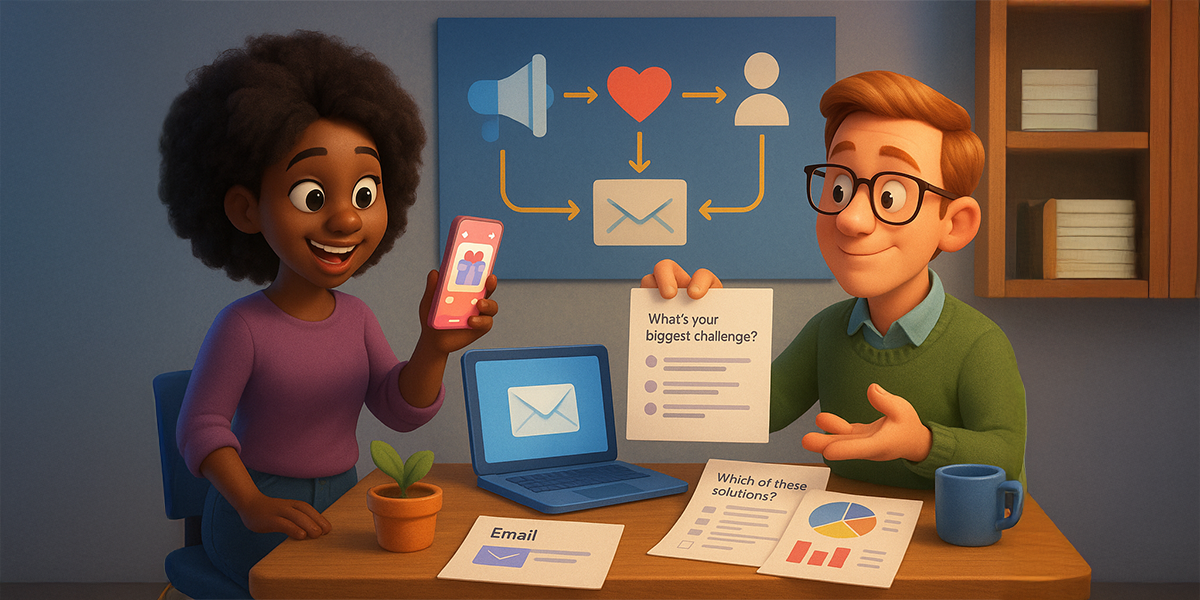We see you want to run an efficient email campaign but if you think you can do that by collecting data from cookies, you are wrong. Gone are the days when marketers could track users all over the web with third-party cookies and run hyper-targeted campaigns without breaking a sweat?
The privacy regulations are increasing (think GDPR, CCPA) and browser-level crackdowns (Google finally phasing out third-party cookies by 2025). With all this, we’re entering a new era. It is the one where first-party data and email marketing are more important than ever.
At Bumppd, we work closely with startups and early-stage founders who often feel overwhelmed by all the heavy lingo: cookies, pixels, retargeting, personalization, segmentation—you name it. But here’s the truth: if you can master first-party data and pair it with a smart email marketing strategy, you’re already ahead of 80% of your competition.
Let’s unpack what that looks like in the real world.
Wait, What Exactly Is First-Party Data Again?
First-party data is the information you collect directly from your customers or audience. That includes names, emails, purchase history, behavior on your site or app, preferences, and even feedback from surveys or chatbots. Unlike third-party data, it’s information you own. No middlemen. No dependency on platforms that can yank access whenever they want.
To simplify it, you can think of it like dating. Third-party data is when a mutual friend gives you someone’s number without them knowing. First-party data is when that person gives you their number directly because they’re genuinely interested.
Why Startups Should Care—Like, Right Now?
If you’re a founder who is trying to scale. You need to build a loyal community. You are required to just get some real traction, relying on paid ads alone isn’t sustainable anymore. Rising ad costs and lower ROI due to loss of third-party data are real problems. Startups who ignore first-party data today will spend double tomorrow to get the same results.
Let’s look at a real life example. One of our clients, a DTC skincare brand, was in pre-launch mode. They had zero customer data and relied heavily on Instagram ads. We built them a simple quiz on their landing page—“What’s Your Skin Type?”—and collected emails plus skin concerns. Within two weeks, they had 2,000+ leads and segmentation-ready data. When we launched the email welcome series tailored to each skin type, their open rates hit 48% and click-throughs were over 10%. No paid retargeting needed.

Email Isn’t Dead—It Just Needs to Evolve
We get it, sometimes due to lack of correct information, email might feel like a dusty channel in a world of TikToks and reels. But hear us out: email marketing is still one of the highest ROI marketing tools out there. Litmus reports that for every $1 spent on email, the average return is $36. And with your own first-party data in hand, those numbers can be even higher.
But blasting the same newsletter to your entire list? That’s legit dead. What works today has to be personalized. It needs to be behavior-driven campaigns that feel less like a brand broadcast and more like a conversation.
Here’s how one of our SaaS clients—an early-stage productivity app—used this. After offering a free trial in exchange for signup, we tagged users based on features they explored in-app. Then, we triggered a drip email sequence based on what they interacted with. If someone used the task prioritization feature heavily, they got advanced tips and upgrade nudges around that. Result? 27% more conversions from trial to paid versus their old one-size-fits-all emails.
Segmentation:- A Solution that Provides Surity
First part data is gold and this is where it shines and proves itself. Your audiences are not faceless blobs, they are people with real needs, or stages in the customer journey. When you group them based on their behavior or requirement, there is a higher chance for conversion.
Here are a few easy ways startups can segment their list:
- New signups vs. returning customers
- Quiz takers vs. freebie downloaders
- People who clicked on Product A but not Product B
- Users who haven’t opened an email in 30+ days
Don’t worry! No fancy CRM is required for segmented targeting, basic tools like Mailchimp, Klaviyo, or ConvertKit let you tag and segment easily. The key is to start collecting the right data from day one. Just asking for people’s name and emails would never be the right way, you do need data that will help you create segments. Factors like preferences, intent, feedback and behavior.
And yes, be transparent. Tell people why you’re asking. In cookieless marketing, consent isn’t just legally necessary—it’s a trust builder.
Zero-Party Data: The Trust and Intrest Builder
If first-party data is what users give you through behavior, zero-party data is what they tell you directly. This will include quizzes and surveys that tell you the preferences, account setups—basically, intentional information shared voluntarily.
This stuff is even more valuable than gold. You do not believe us, let’s prove it through the example.
Let’s go back to our skincare startup. Beyond collecting skin types, we added a follow-up question: “What’s your #1 skincare goal?” Options included things like glow, acne control, anti-aging, hydration, etc. That one question helped us craft subject lines and content that felt 1:1. Emails started with, “Here’s how to get the glow you want—fast,” and people clicked like crazy. Why? Because it wasn’t generic. It felt like it was written just for them.

Automations That Convert (Without Being Creepy)
Now because these campaigns are personalized does not mean automation is not required. In fact, this is where your first-party data does the heavy lifting. Instead of manually writing and sending every email, you build flows triggered by user actions.
A few foundational flows every startup should have:
- Welcome Flow – This is the one that can be triggered when someone signs up.You tell your story while delivering value and offering something exclusive.
- Browse Abandonment – If someone checks out your pricing or product pages and doesn’t convert.
- Cart Abandonment – For e-commerce startups, this one’s non-negotiable. This need to include gentle reminders, urgency nudges, or FAQs. These can recover up to 15% of lost carts.
- Re-engagement Flow – Triggered after 30–60 days of no opens or clicks. Think about subject lines like “Still interested in [benefit]?” or “Should we stop emailing you?”
We helped a startup that sells digital templates set up these four flows in a week. Their welcome emails alone generated $7,500 in revenue in the first month. These entirely came from first-party data and email automation.
The Role of Content in All This
Content is extremely valuable when it comes to this entire scenario. People won’t hand over their email for nothing. You need content that’s genuinely valuable. You will require lead magnets (eBooks, checklists, cheat sheets), interactive tools (quizzes, ROI calculators), or even exclusive early access to new features.
But one thing that is highly important is that all of it needs to be aligned with what users are actually craving for. Don’t build a guide to Facebook ads if your audience is struggling with landing pages. Your key focus should always be on user utility and relevance.
Pro Tip :- Make sure every content asset is tied to an email flow. That free eBook? Trigger a series helping people take action on it. The quiz? Deliver insights and recommendations in a multi-part email series. Content without follow-up is like collecting leads and ghosting them.
What About Social and Ads? Aren’t Those Important Too?
Totally. But here’s the difference, social and ads are top of funnel. They’re how people find you. First-party data and email marketing are how they stay, convert, and refer others.

One startup we worked with ran a lead gen campaign on Instagram with a giveaway. Instead of just collecting emails, we added a few smart questions to the signup flow.“What’s your biggest challenge with [problem]?” and “Which of these solutions have you tried before?” We ended up with segmented data we used for email content. Not only did they triple their open rates, they also got valuable insights for product development.
In Summary: The New Playbook for Founders
You don’t need a massive budget or a huge team to build data-driven campaigns that convert in a cookieless world. You just need the right mindset—and the right data.
Here’s your playbook:
- Start collecting first-party and zero-party data now.
- Segment your audience and treat them like individuals.
- Use automation to stay relevant and timely.
- Create content people actually want.
- Make email your conversion engine—not just a broadcast tool.
At Bumppd, we believe startups deserve marketing strategies that actually move the needle not just vanity metrics. If you’re ready to turn your email list into your biggest revenue driver, let’s talk. Because in a world where data privacy is the new norm, trust and relevance are your superpowers.




 +1-4159652566
+1-4159652566
 +91-8418866099
+91-8418866099
